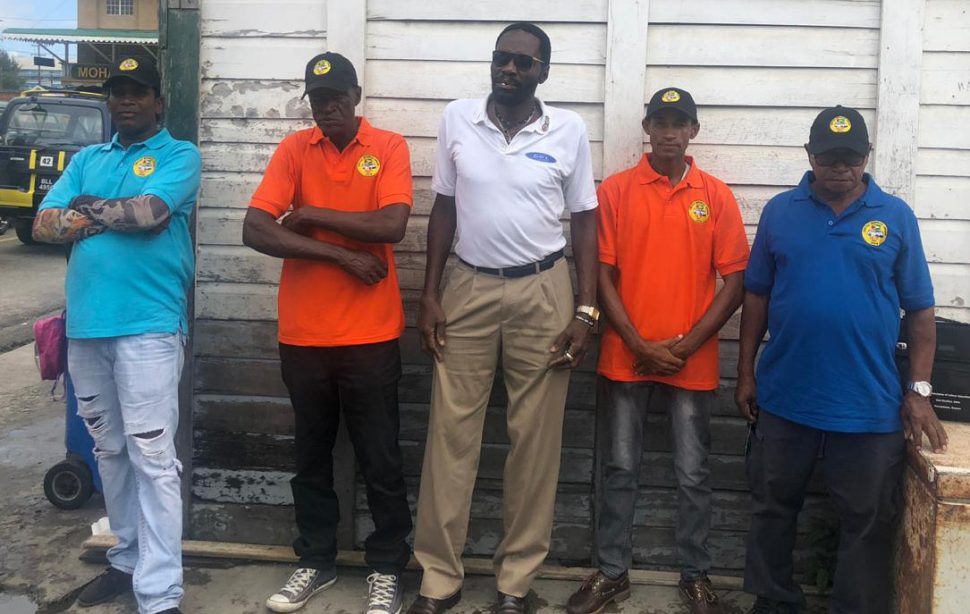While the draft Code of Conduct for minibus operators is still being finalised, some Route 42 drivers have already started wearing uniforms and adhering to other provisions as they are aiming to be the pioneers of a new culture for public transportation.
Ministry of Business Public Relations Officer, Cordell McClure recently told Stabroek News that work was still being done on the code, with the aim of possible implementation next month.
However, led yesterday by the United Minibus Union (UMU) head Eon Andrews, six minibus drivers donned shirts and matching caps at the Route 42 (Georgetown to Timehri) bus park, where they expressed their desire to begin the implementation of the code of conduct.
“…What we have realised is that change is something people don’t conform with too easily. In this sector, there are decent persons just as how you might have rogue elements but they’ve decided that they like the code of conduct and they think it’s a good thing and they want to be pioneers in starting to wear their uniforms,” Andrews explained.
He pointed out that operators who ply the route between the University of Guyana and Georgetown usually wear their own uniforms. He said he hoped that the move will be emulated by some of the other bus operators.
Felix Walker, who is currently facilitating the distribution of shirts and jerseys, explained to Stabroek News yesterday that based on the feedback from other operators, they are interested but they want to first see what implementing the code of conduct is going to achieve for them.
“…You know, change is something very hard because you are accustomed to doing things one way and then there is the tendency of non-compliance. It will take time so as we tell people and as we lead by example, I am hoping that others will follow,” Walker said.
Walker pointed out that most of the persons who operate along Route 42, inclusive of those who only do short drops, do not encourage the culture of overloading or playing loud, lewd music. However, the man pointed out that there are a few “rogue” elements that paint a negative picture about the culture of the park and others.
“Unless we get proper marshalling, the situation won’t ease and I would guess it’s on the police to do that. I look at the UG park and they are very organised. I go to Berbice every week and the Berbice park is very organised and they are part of this association,” Walker said.
He added that discipline is one of the most important factors in determining whether the minibus operators around the country transform the sector into a healthy one. The operations, he said, need to be supervised by a recognised authority, such as the Guyana Police Force.
Walker explained that one of the main contributors to the negativity associated with the industry is the employment by some operators of “touts,” who would often coax commuters into filling buses that have not joined the lines and are on the “hot plate” so that they can move off from the park faster.
However, the drivers who wait in their respective lines for their buses to load have said that the touts are stifling their business.
“When we came at the back here, we started an orderly system and when the touts realise they getting forced out, they come and create mayhem between the drivers. You had bus drivers who used to stay in the line but the touts created a mayhem and that’s how we are in this confusion right now,” another driver explained.
He pointed out that even if police ranks “chase” the touts from the bus parks, they usually come back some hours after and are able to continue their illegal operations unhindered. The man even claimed that some of them work in collusion with the ranks, who would receive monies from them at the end of every week.
“They does be standing up directing traffic and the same touts they chased in the morning is the same touts working the bus. There is a need for consistency and maybe if we can rehabilitate all of those touts to be conductors, that would work,” the man added.
Another operator, Ishmael Benn, is of the opinion that the Mayor and City Council (M&CC) should implement “turn systems” and properly monitor the parks around the city.
“We have no systems. In other countries, they have stewards who monitor the buses. The M&CC could have their people there where they can earn this money. It can bring in revenues for the council,” he noted.
Benn was, however, less enthused about wearing uniforms. “The thing with the uniform, I don’t see the reason. I think there should be more concern about safety and the system because I see it as you taking away our freedom. If a man untidy, giving him a uniform wouldn’t make him tidy,” Benn added.
The Ministry of Business recently published an infomercial on its Facebook page to highlight several guidelines that minibus operators will have to abide by once the code is brought into operation.
Among the guidelines mentioned in the infomercial were the proper display of their fare structure, prohibition of loud and offensive music, prohibition of offensive language, and consideration for vulnerable groups, including the elderly and persons with disabilities.
Additionally, it was noted that operators and associated personnel are expected to wear uniforms, along with an identification badge or card.
The code will be mandatory for all minibus operators.









